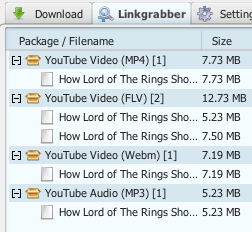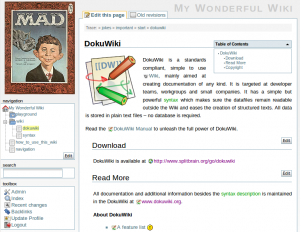Docuwiki : Take notes everywhere … seriously … every-where !
Nov 21Greetings blog readers! It is I, Matt, the stay-at-home g33kdad in Northern California. I am writing today to discuss a topic that has been much on my mind lately and that is “note taking”. I know, Y A W N, right? Who cares? You open a google doc, you jot some stuff down… or maybe I used a MS word doc for that… where did I save that again… is it in Evernote… oh, here’s some paper, i’ll just write it down… but, then I’ll just have to type it up later… and what if I want to work on it at my mom’s house…and if it’s stored on some company’s server somewhere, what kind of privacy is there… nevermind, I’ll just play xbox.
So, in the spirit of T. S. Eliot who wrote that immature poets copy while mature poets steal, I steal this from Allison Sheridan of the Nosillacast Podcast, “What is the problem to be solved?”
The problem, as I see it, is keeping track of information digitally (whether or not the information started out digital). Now, unless you have been living under a rock for the recent past, you probably have an opinion on “cloud” services and computing. There are many different services available. The ubiquitous choice seems to be Evernote. Evernote is a service that allows you to store your notes on an internet accessible server. This gives you access to them from anywhere you have an internet connection. There are apps for all the major mobile platforms and for most desktop operating systems. This is a very full-featured service and very powerful, as well.
Another option is to use Google Docs or another hosted word processor. This is a great option because the interface is similar to MS Word or other word processing programs and most of the formatting options you would have on the desktop are available in your web browser.
While these are good options, they have some flaws. They require a third-party to host your notes. Having someone else handle the server maintenance and software is great, but you have to deal with privacy concerns. You also have to deal with connectivity to that service. What if you have an internet outage or you find yourself somewhere without wifi. (Do you go places without wifi?) How do you add, edit, or read notes? Also, some services may not be designed for robust note-taking.
When it comes to third-party, cloud services, my personal feelings are these: 1. Any technology can be used to make my life better. 2. Any technology I don’t own or control can be used to make my life worse. So I have to make a choice. Do I want the convenience of a service designed to meet the need? Do I want to keep all my notes in plain text on my personal computer? Is there another choice?
I have decided that a wiki is a very flexible platform for what I want to do. In case you don’t know, a wiki (see: http://www.wikipedia.org/wiki/
There are some caveats to this. Wiki software is a web app that runs (in most cases) on a webserver. So you need to have access to a webserver to utilize a wiki. This can be a shared hosting account, a vps, or a small server in your home. The requirements are minimal. In some cases, wikis can be complicated to set up.
So, what do I do? I use a package called DokuWiki. DokuWiki is related to MediaWiki which is the software that powers one of the most famous wikis in the world, wikipedia.org. It is a powerful package and works great for note-taking. There are many plugins available to change the syntax, provide for different content types and many other extensions. I have installed it on my home server and use it most every day for my needs. But there was a slight hiccup. I still needed internet access to make notes. Not a big deal when I’m on my home network, but even with dynamic DNS, I won’t have access if I can’t get to the internet. Then, I discovered the “killer app”. There is a plugin called sync (http://www.dokuwiki.org/
I have just scratched the surface of the possibilities of using DokuWiki for online note-taking. There are so many other uses for a wiki and I know that DokuWiki is so easy to deploy, I will be using it again.
Thanks for taking the time to read this article. More to come!
You can find more of Matt online at @sahgeekdad on twitter or via g33kdad.thestrangeland.net
Related Posts
Herd your ideas with Mindmeister.
Nov 09A creative mind can be a blessing in disguise. As most ADD-prone geeks can confirm, it is often harder to herd your ideas then it is to have them at all. How do you keep track of it all ? Sure there are tons of “to-do” and “GTD” apps to be found out there, but the question is : “Do you have them with you when you need them ? ” That was one of the showstoppers when it came to my use of “Ithoughts HD” on the iPad. A truly wonderful mind-map application with plenty of features and dingdongs, but also very “local”. Not only was it only available on IOS, The mind-maps it produced were also stored locally on the device .. This would not do .. It would not do at all.

What you really need is a Cross platform mindmapping application that is available anywhere. On your tablet when you are in a meeting, On your desktop, when you want ‘the big picture’ and on your phone when you are on the road and get that million dollar idea. You want it everywhere, anytime and all in sync. And we have your answer.
Enter Mindmeister. Available via a web interface and via the Google play store and the Ios App store the app gives you online and offline access to your mind maps. If you sign up for a free account you will have a maximum of 3 maps. A payed account at 5,10 or 15 dollars a month gives you loads of extra features and collaboration. But even the free version allows you to share your maps with others.
Using mindmeister is very easy. It might not come with a ton of bells and whistles, but its about working on your idea, not about fancy colored bubbles. As an added bonus they have cross platform widgets and browser extensions to quickly dump your bright light bulbs into Mindmeister.
Mindmeister gets two thumbs up when it comes to “anywhere anytime” and is very slider friendly. Available at www.mindmeister.com , the Google Play store and the Apple App store.
Related Posts
DOTW : Jdownloader : The ultimate Youtube Downloader.
Apr 11
Download of the week : Until a while ago I used an app on my Mac (I have even forgotten the name) to download any Youtube video’s I needed for the podcast or for some of my presentations. When upgrading to Lion, it decided (or rather Lion decided) it wouldn’t work anymore. Tough 🙁 I had found some alternative online sites to do it but searching for solutions like this is one of those internet ratholes like looking for free mp3 ringtones.) When twiddling around with it I had one of my favorite cross-platform download apps open in the background : Jdownloader. I use Jdownloader for multi-url links and long running downloads. Its free, its cross platform and it has this handy “url catcher” where it notices when you copy a url to your clipboard and then offers to download it. When the activity window for Jdownloader started blinking I checked out the “link grabber” window and was amazed to find that not only it had “caught” the url of the Youtube video I copied, but it offered to do something more. Jdownloader will offer to download AND CONVERT your Youtube video into several sizes like : MP3, FLV, MP4, Webm and more (depends on the video) So this tool is something that should not be missing in your application folder on ANY of your systems.
Download Jdownloader ( mac – lin – win ) here.






